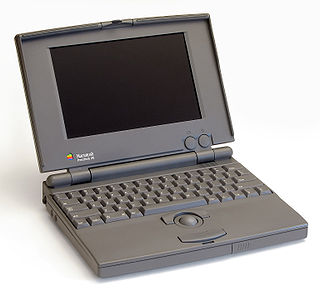
Marketing is the act of satisfying and retaining customers. It is one of the primary components of business management and commerce.
Lotus Software was an American software company based in Massachusetts; it was "offloaded" to India's HCL Technologies in 2018.

John Sculley III is an American businessman, entrepreneur and investor in high-tech startups. Sculley was vice-president (1970–1977) and president of PepsiCo (1977–1983), until he became chief executive officer (CEO) of Apple Inc. on April 8, 1983, a position he held until leaving in 1993. In May 1987, Sculley was named Silicon Valley's top-paid executive, with an annual salary of US$10.2 million.
Positioning refers to the place that a brand occupies in the minds of the customers and how it is distinguished from the products of the competitors. It is different from the concept of brand awareness. In order to position products or brands, companies may emphasize the distinguishing features of their brand or they may try to create a suitable image through the marketing mix. Once a brand has achieved a strong position, it can become difficult to reposition it. To effectively position a brand and create a lasting brand memory, brands need to be able to connect to consumers in an authentic way, creating a brand persona usually helps build this sort of connection.

Guy Takeo Kawasaki is an American marketing specialist, author, and Silicon Valley venture capitalist. He was one of the Apple employees originally responsible for marketing their Macintosh computer line in 1984. He popularized the word evangelist in marketing the Macintosh as an "Apple evangelist" and the concepts of evangelism marketing and technology evangelism/platform evangelism in general.

eWorld was an online service operated by Apple Inc. between June 1994 and March 1996. The services included email, news, software installs and a bulletin board system. Users of eWorld were often referred to as "ePeople."
4D is a relational database management system and integrated development environment developed by Laurent Ribardière. 4D was created in 1984 and had a slightly delayed public release for Macintosh in 1987 with its own programming language.
A technology evangelist is a person who builds a critical mass of support for a given technology, and then establishes it as a technical standard in a market that is subject to network effects. The word evangelism is borrowed from the context of religious evangelism due to the similarity of sharing information about a particular concept with the intention of having others adopt that concept. This is typically accomplished by showcasing the potential uses and benefits of a technology to help others understand how they can use it for themselves.

The PowerBook 100 is a portable subnotebook personal computer designed and manufactured by Sony for Apple Computer and introduced on October 21, 1991, at the COMDEX computer expo in Las Vegas, Nevada. Priced at US$2,500 with external floppy drive, the PowerBook 100 was the low-end model of the first three simultaneously released PowerBooks. Its CPU and overall speed closely resembled those of its predecessor, the Macintosh Portable. It had a Motorola 68000 processor at 16 MHz, 2-8 megabytes (MB) of RAM, a 9-inch (23 cm) monochrome backlit liquid-crystal display (LCD) with 640 × 400 pixel resolution, and the System 7.0.1 operating system. It did not have a built-in floppy disk drive and was noted for its unique compact design that placed a trackball pointing device in front of the keyboard for ease of use.
A core product or flagship product is a company's primary promotion, service or product that can be purchased by a consumer. Core products may be integrated into end products, either by the company producing the core product or by other companies to which the core product is sold.
Evangelism marketing is an advanced form of word-of-mouth marketing in which companies develop customers who believe so strongly in a particular product or service that they freely try to convince others to buy and use it. The customers become voluntary advocates, actively spreading the word on behalf of the company.
Marketing effectiveness is the measure of how effective a given marketer's go to market strategy is toward meeting the goal of maximizing their spending to achieve positive results in both the short- and long-term. It is also related to marketing ROI and return on marketing investment (ROMI). In today's competitive business environment, effective marketing strategies play a pivotal role in promoting products or services to target audiences. The advent of digital platforms has further intensified competition among businesses, making it imperative for companies to employ innovative and impactful marketing techniques. This essay examines how various types of advertising methods can be utilized effectively to reach out to potential consumers
Return on marketing investment (ROMI) is the contribution to profit attributable to marketing, divided by the marketing 'invested' or risked. ROMI is not like the other 'return-on-investment' (ROI) metrics because marketing is not the same kind of investment. Instead of money that is 'tied' up in plants and inventories, marketing funds are typically 'risked'. Marketing spending is typically expensed in the current period.

John Jantsch is an author, speaker, and marketing consultant who specializes in assisting small businesses.

The Mac, short for Macintosh, is a family of personal computers designed and marketed by Apple Inc. The name Macintosh is a reference to a type of apple called McIntosh. The product lineup includes the MacBook Air and MacBook Pro laptops, and the iMac, Mac Mini, Mac Studio, and Mac Pro desktops. Macs are sold with the macOS operating system.
Sales process engineering is intended to design better ways of selling and make salespeople's efforts more productive. It has been described as "the systematic application of scientific and mathematical principles to achieve the practical goals of a particular sales process". Paul Selden pointed out that in this context, sales referred to the output of a process involving a variety of functions across an organization, and not that of a "sales department" alone. Primary areas of application span functions including sales, marketing, and customer service.
Cunningham Communication, Inc. was a prominent public relations firm in Silicon Valley in the 1980s and 1990s that had many well-known clients in high-tech, including Adobe, Cisco, Motorola, PeopleSoft, Hewlett-Packard, and the IBM Consumer Division. It was founded by Andy Cunningham in 1985, after she left Regis McKenna.

Engage!: The Complete Guide for Brands and Businesses to Build, Cultivate, and Measure Success in the New Web is a bestselling book by speaker, digital analyst, and author Brian Solis. In Engage!, Solis provides an in-depth analysis of social media as a tool used in businesses. He focuses on how to leverage it to be successful in the world of business. In other words, Solis brings forth the tips that people can use to best market their products or services. Actor Ashton Kutcher wrote the foreword.

Mike Boich was a major figure at Apple Computer who was in charge of demonstrating the first Macintosh to software developers and potential customers. He is notable as a technology evangelist who persuaded developers to write computer software. He was instrumental in hiring Apple entrepreneur Guy Kawasaki. His name is listed — as credited — inside the original Macintosh 128k.

Ellen Petry Leanse is an American author, businesswoman, educator, entrepreneur, and online community pioneer. Leanse has spent 35 years working with leaders at Apple, Google, Facebook, as an entrepreneur, and with dozens of startups. She's a writer on topics of workplace dynamics and a Stanford instructor. Her work has spanned entrepreneurship, corporate leadership, investing, and strategy consulting.










